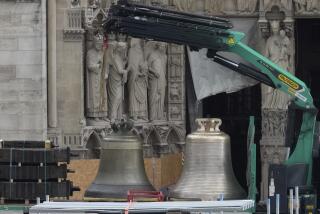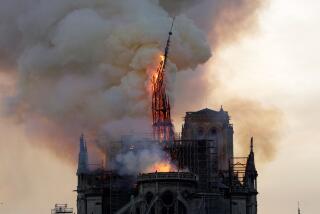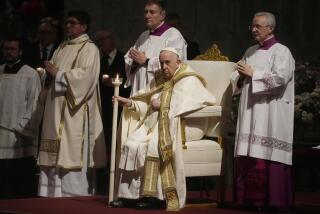Restoration Brings Color to St. Peter’s Basilica
VATICAN CITY — With bows to both modern technology and divine inspiration, Pope John Paul II on Thursday blessed a $5-million face lift of St. Peter’s Basilica that has produced surprise and controversy on the eve of the Roman Catholic Church’s millennium celebration.
Hidden by layers of grayish grime, St. Peter’s Baroque travertine facade, built in the 17th century, was long thought to be monochrome. What emerged as the scaffolding began coming down in mid-September after a two-year scrubbing was a dramatic array of color.
Creamy white columns now stand out against pale, straw-colored walls on the lower part of the facade. The upper part, which supports statues of Christ and his 12 apostles, matches the color of the columns. In the central balcony, where popes address the world after their election, two red pilasters stand next to a green-tinted wall.
The basilica will be center stage for the Vatican’s yearlong celebration of a new millennium, when millions of pilgrims will visit Rome. The pope plans a personal greeting of the faithful gathered in St. Peter’s Square nearly every day in the year 2000.
ENI, the Italian state energy company whose gasoline and diesel fuel produce the exhaust fumes that help coat Rome in grime, financed the make-over of the facade, which has an area about the size of a football field.
While generally pleasing to tourists, the project has drawn fire from architectural critics. Some contend that the patterns of color are not original decorative washes, as the Vatican says, but residues of accumulated pollution, dust and dirt. Others suspect that the Vatican added its own colors to render the basilica more telegenic.
“The solemn unity of the original facade has disappeared,” architectural historian Carlo Bertelli wrote recently in an Italian newspaper commentary headlined “A Betrayal in the Name of TV.”
Vatican restorers insist that the colors date to Renaissance architect Carlo Maderno’s original design, or in the case of the red and green, were added a century after his death to ornament the balcony.
“New colors were not added to a white travertine facade,” Sandro Benedetti, head of the St. Peter’s workshop at the Vatican, told reporters this week. “A faded color emerged from under the grime. The existing colors were those conferred by Maderno.”
Benedetti pointed to historical documents, including a large order of brushes he said Maderno used to color the marble with river sand and brick powder. The restorers said they consulted a 17th century painting of the colorful facade and ran exhaustive scientific tests at ENI’s labs in Milan to show a patina of color between the grime and the travertine.
John Paul came down firmly on the side of the restorers in a speech Thursday night to a gala gathering at the basilica.
“Thanks to their work, carried out with great artistry and competence, the Vatican Basilica, already beautiful inside, is shown now in all the solemn majesty of the facade adorned by Maderno,” the pope said.
He praised the Lord “for giving mankind the capacity to master materials and ennoble them.”
Maderno finished erecting the facade in 1616 for Pope Paul V, after the pontiff had demolished a sagging, earlier facade.
Restorers cleaned grime from the faces of stone angels, repaired cracks in the travertine, polished halos and patched mosaics. They put protective coats on the copper and iron propping up clocks and saints, and installed an electrostatic system to keep birds away from the facade and halt what one project report called “bird pollution.”
More to Read
The biggest entertainment stories
Get our big stories about Hollywood, film, television, music, arts, culture and more right in your inbox as soon as they publish.
You may occasionally receive promotional content from the Los Angeles Times.










